The Leupold gold ring has long been the hallmark of quality and trust for hunters around the world. Bit by bit, Leupold has been earning the trust of the military and law enforcement community as well with a series of long-range tactical optics. Now, with the Leupold Patrol 6HD 1-6X24, one of America’s oldest optics brands has offered an LPVO worthy of the brand’s legacy.
I tend to like Leupold scopes, a lot. They feature consistently great glass and I’ve come to expect that of all of their better product lines. Even so, I was genuinely surprised with the clarity of the Patrol 6HD, at every magnification.
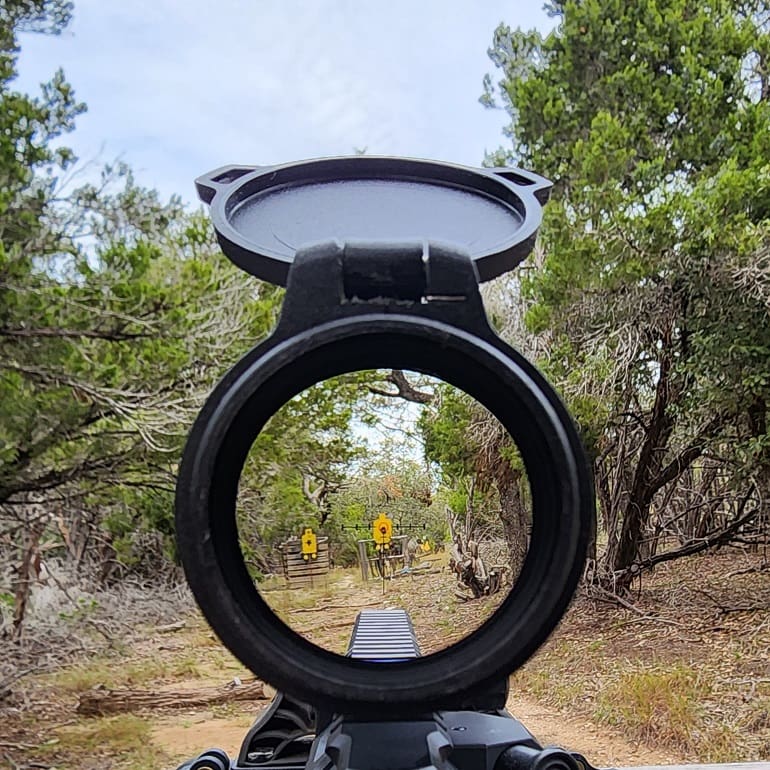
Take a look at the 1X image above. It’s crisp and sharp with no discernible color shift. At 1X (and it’s a true 1X), it’s like looking through a window…a bright, clean, crystal-clear window.
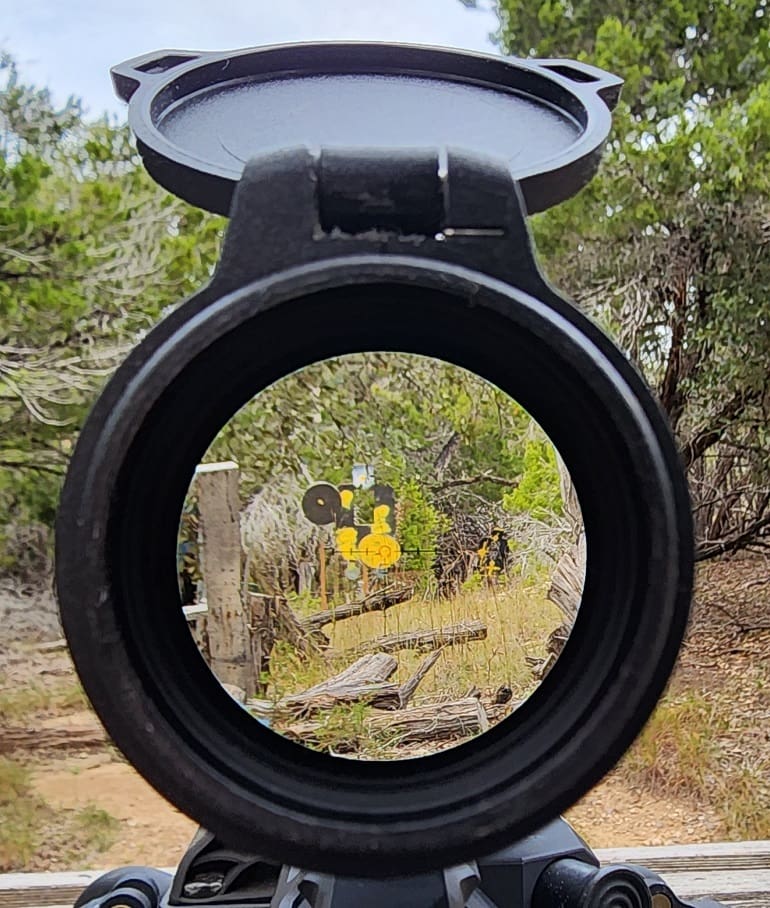
The eye box is amazing. I took the photo at 6X above with my camera phone. I’m able to do that less and less because of the automatic lens swapping on newer phone cameras, but I didn’t do anything other than place the phone a few inches behind the glass and tap the button. My eyes told me the same story.
The Patrol rifle scope is very easy to get into. The image pops right up as you shoulder the gun. What’s particularly nice is that the eye relief barely changes at all between minimum and maximum magnification.
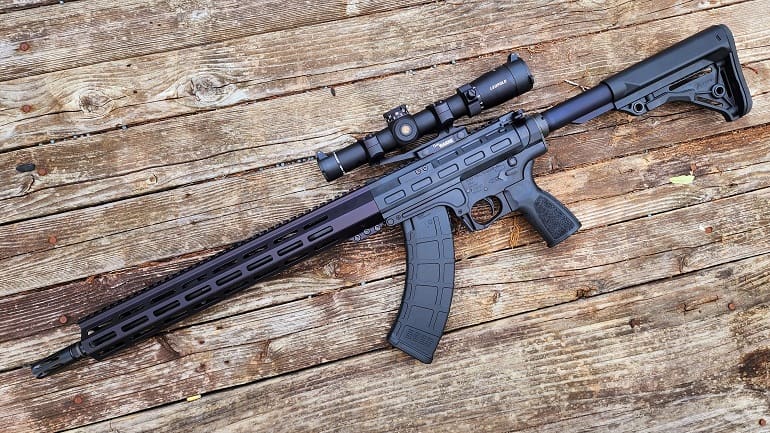
I performed a simple box test with the reticle mounted on a 21st TEC TEC-47 and found the adjustments tracked within the limits of the platform and ammunition. I also just sat around and moved the turrets a lot in every direction and then reset them to zero. Rounds landed in the same spot as before I moved them in the first place. Out to 600 yards, if there was any deviation in the turret adjustment, it was beyond my ability to measure.
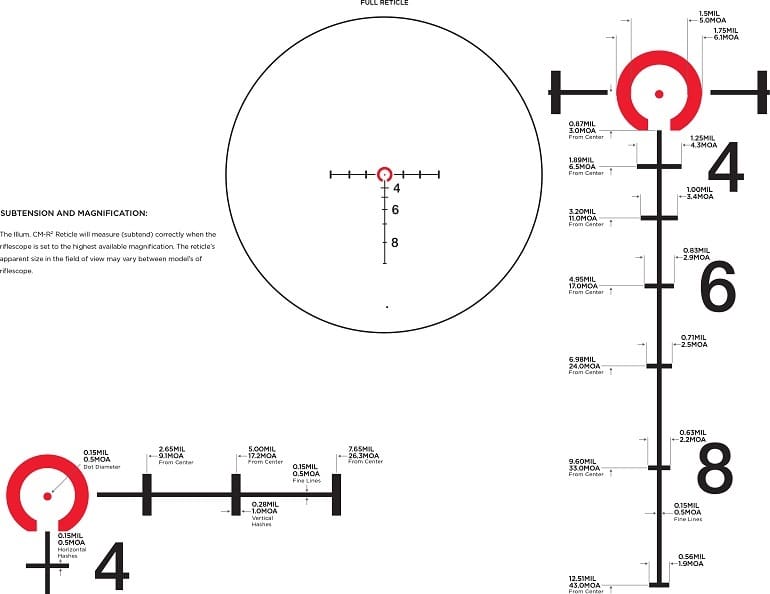
There are two reticle options available for this scope, a simple heavy line duplex model and the one that this particular optic carries, the CM-R2 reticle. For those of you familiar with the original ACOG so many of us carried in combat, the CM-R2 is going to look very familiar. It features an illuminated center dot in a donut with movement/windage and elevation subtensions.
There’s a lot going on inside that small space, but if you dedicate yourself to understanding it, the CM-R2 reticle provides the shooter with a ton of information. It only subtends “correctly” at 6X, but if you wanted you could break out a tall target and detail the subtensions at every magnification range.
As it is, you’ll know anything inside that center donut’s inside edge at 100 yards is going to fall inside a 5″ circle, and anything inside that donut’s outside edge at 300 yards is going to land somewhere inside an 18″ circle. Full details on the reticle can be found on the Leupold website.
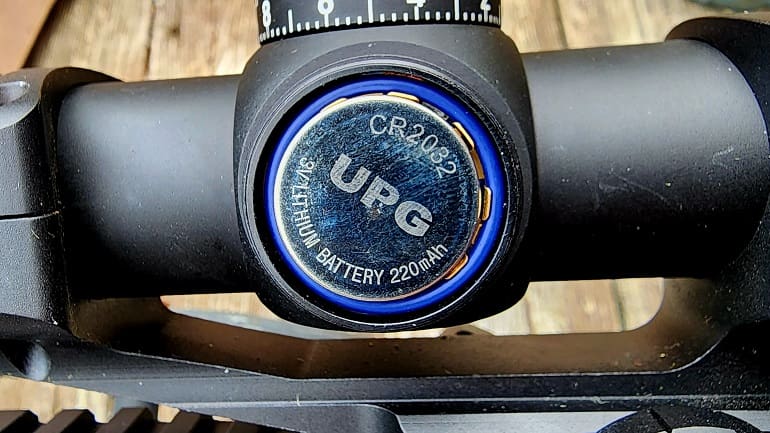
Illumination is powered by a single CR2032 battery tucked into the left side housing. A single side button controls brightness, cycling through the eight brightness levels, up and down. The highest setting was bright enough to see a faint red glow even under the brightness of a full Texas sun.
The optic isn’t advertised as night-vision capable, but at its lowest setting, it wasn’t visible to the naked eye. Mounting an AN/PVS 14 and looking through the optic at its lowest illumination setting, I was surprised to find that the reticle didn’t wash everything out, but appeared as one fuzzy roughly 6 MOA dot in the center of the image.
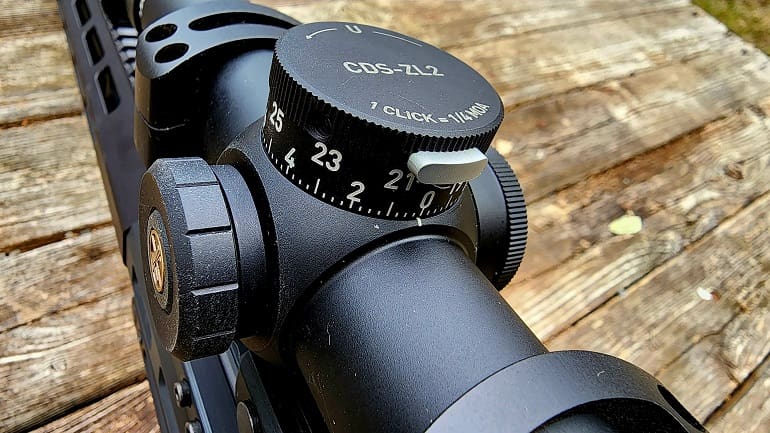
Image courtesy JWT for the truthaboutguns.comThis model includes the Leupold Custom Dial System. I use this system on a few of my hunting rifles and it works exactly as advertised. You submit your ballistic data online through Leupold’s website and they send you one free turret dial to match the ballistics you’ve reported.
If you do your job right, all you have to do is dial to the number on the turret that corresponds to the distance. At 200 yards, you dial to the 2. At 450 yards, you dial to number 4 and a half. Keep the gun steady, pull the trigger, and that’s where the round will land (assuming no wind call). Easy peasey lemon squeezy.

The supplied elevation turret is well marked and locks in tight with a single center button. Windage is equally well marked but capped. This exposed elevation and capped windage is definitely my preferred system as, like a lot of shooters, I like to dial elevation but hold for changing winds.
If I had one complaint it’s that the adjustment clicks are more like clunks than sharp clicks, if that makes sense. That’s a tiny nitpick as they’re easy to hear and feel. Counting clicks is a bad habit to get into, especially since the turrets themselves are well and obviously marked. That said, if you master the supplied reticle, you won’t likely be dialing elevation or windage except at the longest of ranges with the smallest target scenarios.
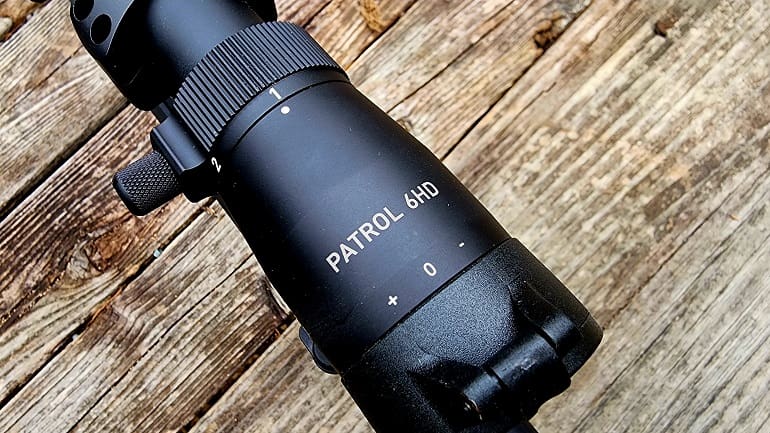
As with all of my optic tests, I put the scope in the freezer overnight, pulled it out and shot it. There were no failures, no fogging, and the point of impact didn’t shift more than what was allowed for remounting the optic.
I also dunked it in the tub for half an hour. I very much appreciate Leupold’s Guard-Ion coating. Water slid right off the glass and didn’t leave so much as a smudge. For a “combat” focused optic, shedding water and dirt without ruining the image clarity is a huge advantage.

Weighing in at barely a pound, the Patrol 6HD doesn’t add much weight to a gun and at just under 11″ total, it doesn’t take up much space on the rail.
For an LPVO, the Leupold Patrol 6HD is about as perfect as I can think of. For a “patrol” optic, the CM-R2 reticle is ideal, and the image quality is best-in-class. It’s got a few more features, like leveling reticle and auto-off on the illumination, but it’s the basics that matter and Leupold got them right.
Specifications: Leupold Patrol 6HD 1-6X24 CDS-ZL2 with CM-R2 Illuminated Reticle
Main Tube Diameter: 30 mm
Total Length: 10.8 in.
Weight: 16.2 oz.
Elevation per Click: 1/4 MOA
Elevation Adjustment Range: 170 MOA, 49 MIL
Elevation Adjustment Per Revolution: 20 MOA
Elevation Dial Travel Limit: 38 MOA
Windage Adjustment Value per Click: 1/4 MOA
Windage Adjustment Range: 170 MOA, 49 MIL
Windage Adjustment Per Revolution: 20 MOA
Objective Lens Diameter: 24mm
Eye Relief Low Mag: 3.7 in.
Eye Relief High Mag: 3.8 in.
Fixed Parallax-Free Distance: 150 yds.
Battery Life, Low Intensity: 1600 hrs.
Battery Life, Medium Intensity: 1000 hrs.
Battery Life, High Intensity: 300 hrs.
MSRP: $1,599.99 (about $1399 retail)
Rating (out of five stars):
Overall * * * * *
Zero deductions. It’s light, durable, the turrets are right, the reticle is ideal for the intended task, and the image quality is perfect. Pair that with smart controls and Leupold’s warranty and reputation, and we’re left with one of the best, if not the best, LPVOs on the market.

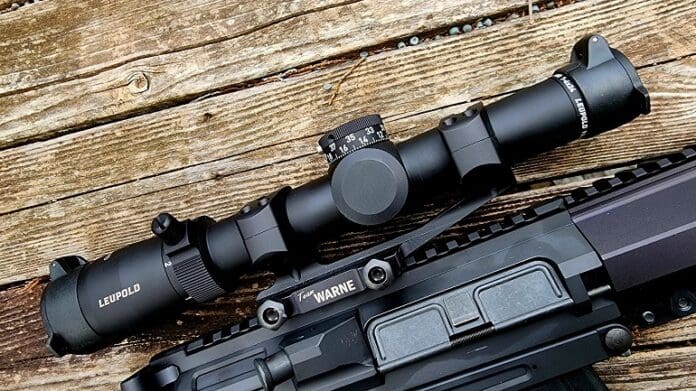



Leupold optics are all I own. Since ’81? I tend to be brand loyal. I like this scope and know exactly which rifle I’d like to mount it on.
be worth that.
i’d like to have one nice, new scope.
nice to see that steel warne on there, tough stuff.
With the exception of .22LR, Leupold and (to a lesser extent) Burris are usually where I start when I’m looking for new glass for a rifle. There are certainly nicer and (*much*) more expensive options, but Leupold tends to maintain a good starting point for me.
I am a recent convert and huge fan of 1-6x scopes for close-quarters combat scenarios.
If your engagements are really up close and personal, you just dial down magnification to 1x (no magnification) and you can keep both eyes open.
Of course if you need to “reach out and touch someone” at distance, you can dial up to 4x or even 6x although you will probably want to close your eye which is not behind the eyepiece.
Best of all, there are no batteries that you absolutely have to replace (assuming that you have a reticle that is visible in daylight without internal illumination).
I’ve got back to the red dot from the LPVO because of parallax. This optic is better than most, but still nothing like the 50 yard parallax limit of even halfway good red dots. There were times in combat I had my rifle flat on the ground, or flat against the hood of a vehicle with a red dot, and still effectively engaging targets. Being able to shoot from wildly non-traditional positions is a huge advantage I’m not willing to give up for magnification.
Mr. Taylor,
Oh, that is interesting. Any chance that you could write a short-ish article (with more details than your paragraph) on that very dynamic?
Something else that I did not mention in my comment above: a scope gathers more light than your unaided eye and it enables better target discernment in low-light conditions. That is yet another advantage of a scope over a red-dot (which does not gather and concentrate light as far as I know–although I could be wrong in that regard and welcome correction if that is the case).
Fun question: does a scope actually gather light, create brighter images, and increase target discernment in low-light conditions when it is set to 1x magnification (which is NO magnification)? My quick intuitive answer to that question is, “no”.
Mr. Taylor,
By the way I believe that rifle scope parallax behavior recently derailed my attempts to verify zero on my white-tail deer hunting rifles (chambered in .44 Magnum) which led me to abandon them in favor of my muzzleloaders (which are tack-drivers). And that, in turn, may have cost my adult child and I a HUGE mature white-tailed deer buck. And when I say HUGE, I mean a BEAST that would have weighed in the neighborhood of 270 pounds AFTER field dressing. So, any articles which highlight parallax-induced inaccuracy would be well received.
(Why did my “tack driver” muzzleloaders cost my adult child and I a deer? We did not realize that the bullets that we are using in our muzzleloaders often fail to expand which means your deer leaves no blood and no fur and runs upwards of 1/4 mile away before keeling over. And that means we never recover it. And no, we did not miss.)
https://dev.thetruthaboutguns.com/scopes-beginners-parallax-adjustment/
Thank you sir.
Does this unit have a zero stop? I am asking for a friend….
Yes, it includes their CDS Zero Lock System.
👍
Doesn’t matter what scope I duct tape to the AK.
Nice to have options. I’ll keep my ACOG’s. Have two gold ring and two black ring Leupy’s. Wish I still had my 20+yr old 3.5-10×50 with heavy duplex. That was a heckuva scope. Sold it like a dummy.
Help me wrap my mind around the the reticle and how you’d zero with a differing load. For example I shoot mainly 77gr SMKS, but the BDC is aligned to a 62gr M855 going at 2800 FPS. Do I adjust my zero or do I dial it’s fairly hard for me to understand.
You would figure out what the hash marks correspond to with your load using something like Strelok Pro (well, if it wasn’t banned).
Comments are closed.